Abstract
The potential of nonterminal cellular differentiation to stably repress the expression of the neoplastic phenotype of transformed cells is established. Nonterminal differentiation induces spontaneously transformed 3T3 T cells to revert to a nontransformed state and induces the revertant cell clones to become resistant to retransformation by UV irradiation or 4-nitroquinoline oxide treatment. Nonterminal differentiation also induces simian virus 40-transformed 3T3 T cells to repress expression of the large tumor antigen and to revert to a nontransformed state. Although the molecular mechanisms that mediate these and other forms of anticancer activity have not been definitively established, data are presented which suggest that differentiation-induced repression of large tumor antigen expression can be regulated at the level of transcription and/or RNA processing.
Full text
PDF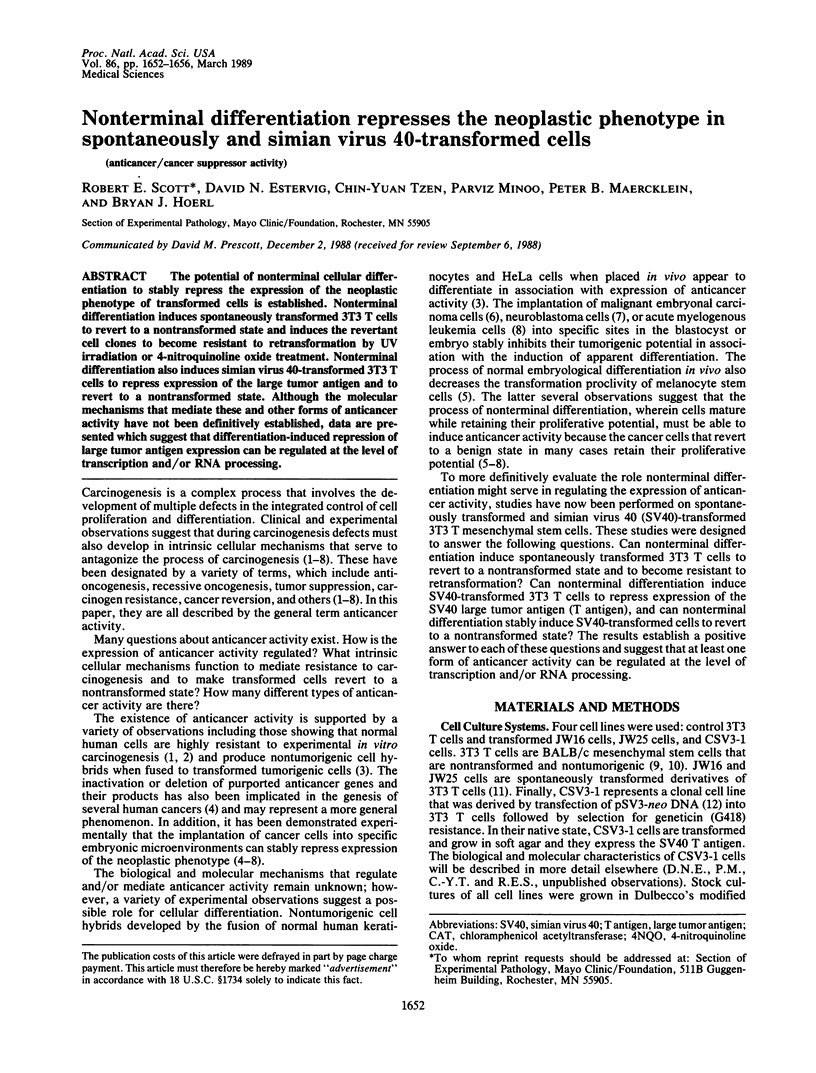
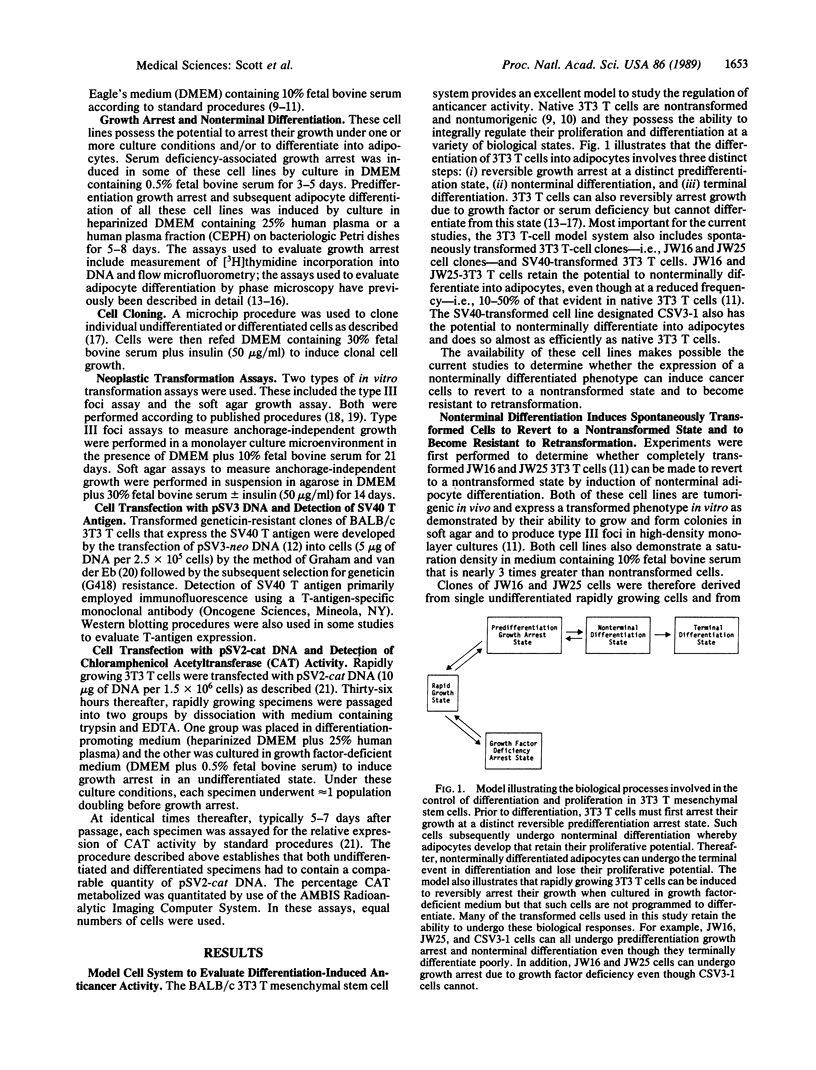
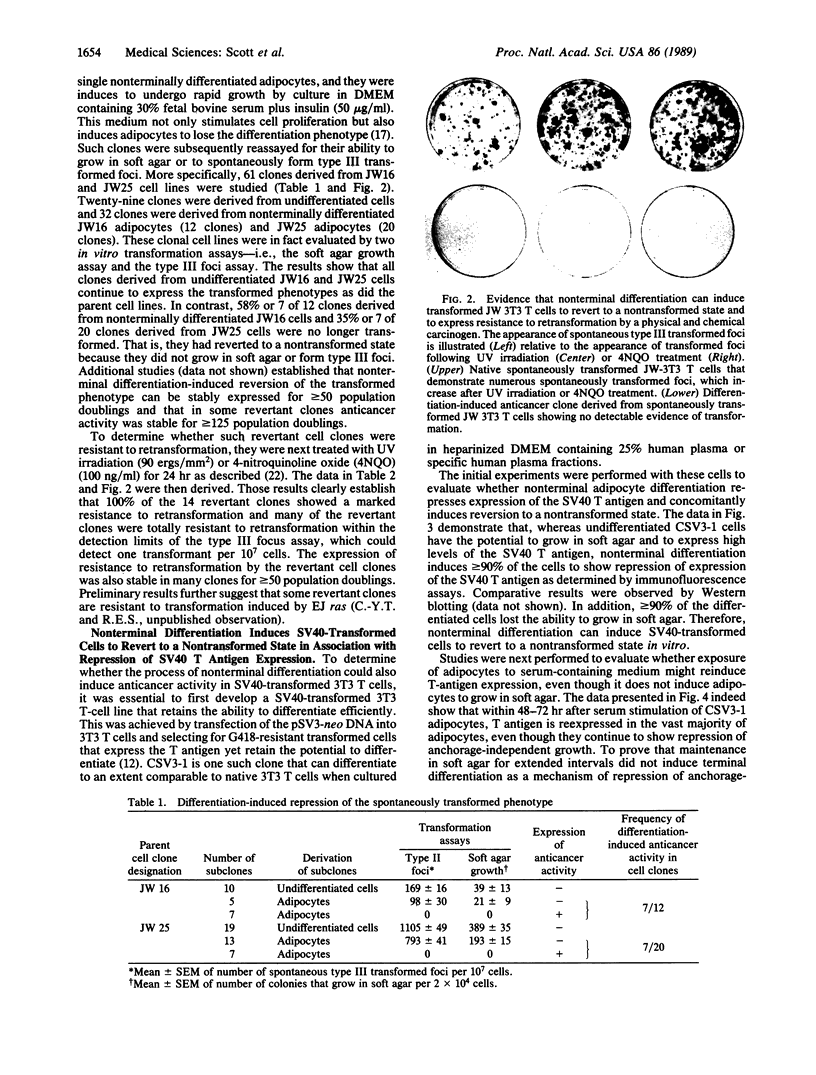
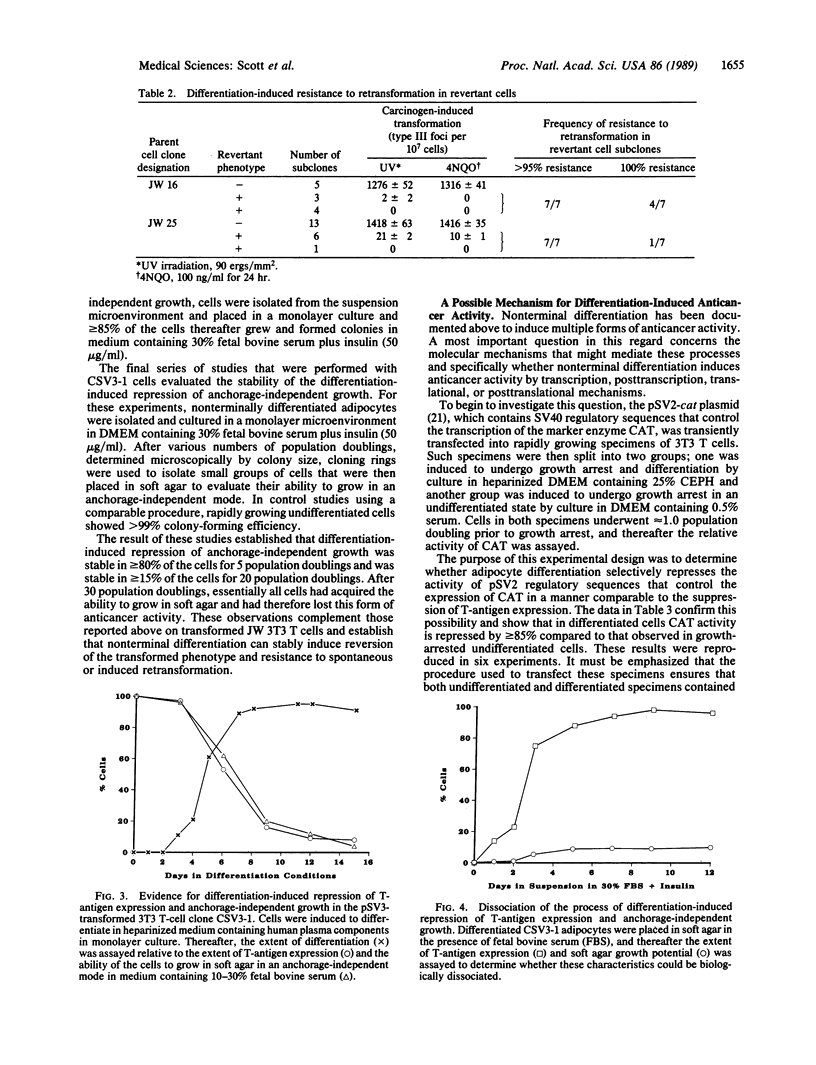
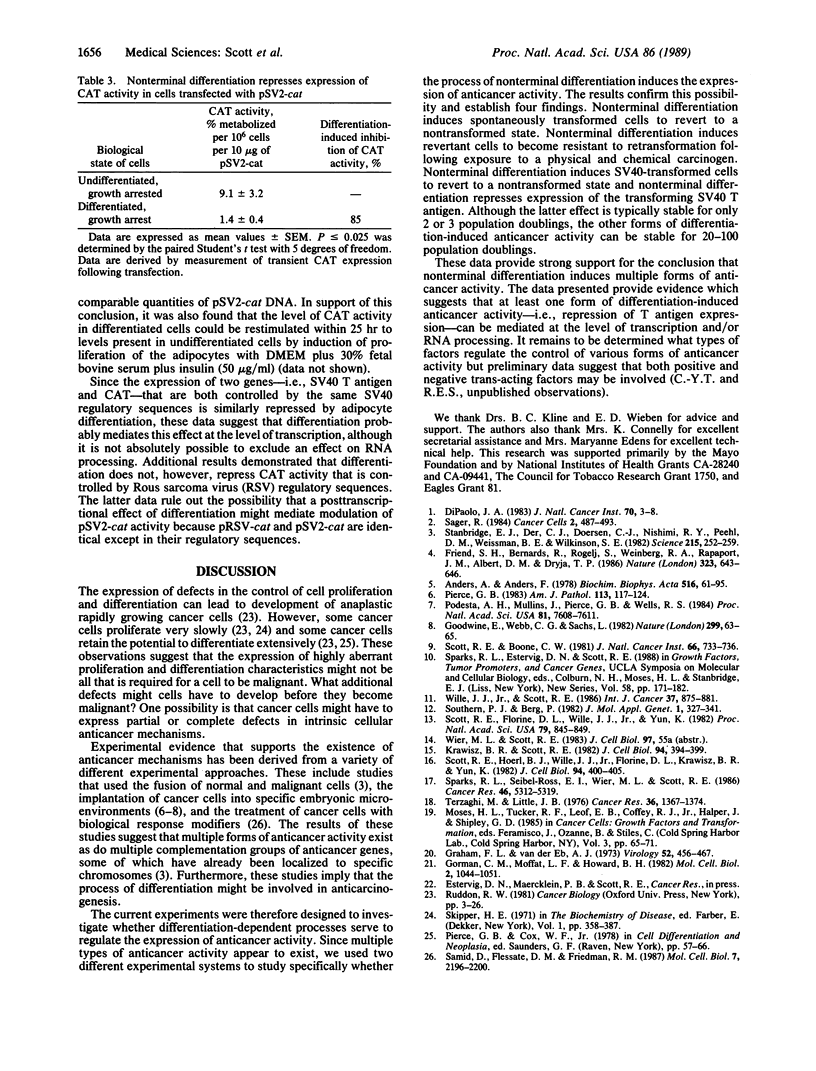
Images in this article
Selected References
These references are in PubMed. This may not be the complete list of references from this article.
- Anders A., Anders F. Etiology of cancer as studied in the platyfish-swordtail system. Biochim Biophys Acta. 1978 Sep 18;516(1):61–95. doi: 10.1016/0304-419x(78)90004-5. [DOI] [PubMed] [Google Scholar]
- DiPaolo J. A. Relative difficulties in transforming human and animal cells in vitro. J Natl Cancer Inst. 1983 Jan;70(1):3–8. [PubMed] [Google Scholar]
- Friend S. H., Bernards R., Rogelj S., Weinberg R. A., Rapaport J. M., Albert D. M., Dryja T. P. A human DNA segment with properties of the gene that predisposes to retinoblastoma and osteosarcoma. Nature. 1986 Oct 16;323(6089):643–646. doi: 10.1038/323643a0. [DOI] [PubMed] [Google Scholar]
- Gootwine E., Webb C. G., Sachs L. Participation of myeloid leukaemic cells injected into embryos in haematopoietic differentiation in adult mice. Nature. 1982 Sep 2;299(5878):63–65. doi: 10.1038/299063a0. [DOI] [PubMed] [Google Scholar]
- Gorman C. M., Moffat L. F., Howard B. H. Recombinant genomes which express chloramphenicol acetyltransferase in mammalian cells. Mol Cell Biol. 1982 Sep;2(9):1044–1051. doi: 10.1128/mcb.2.9.1044. [DOI] [PMC free article] [PubMed] [Google Scholar]
- Graham F. L., van der Eb A. J. A new technique for the assay of infectivity of human adenovirus 5 DNA. Virology. 1973 Apr;52(2):456–467. doi: 10.1016/0042-6822(73)90341-3. [DOI] [PubMed] [Google Scholar]
- Krawisz B. R., Scott R. E. Coupling of proadipocyte growth arrest and differentiation. I. Induction by heparinized medium containing human plasma. J Cell Biol. 1982 Aug;94(2):394–399. doi: 10.1083/jcb.94.2.394. [DOI] [PMC free article] [PubMed] [Google Scholar]
- Pierce G. B. The cancer cell and its control by the embryo. Rous-Whipple Award lecture. Am J Pathol. 1983 Oct;113(1):117–124. [PMC free article] [PubMed] [Google Scholar]
- Podesta A. H., Mullins J., Pierce G. B., Wells R. S. The neurula stage mouse embryo in control of neuroblastoma. Proc Natl Acad Sci U S A. 1984 Dec;81(23):7608–7611. doi: 10.1073/pnas.81.23.7608. [DOI] [PMC free article] [PubMed] [Google Scholar]
- Samid D., Flessate D. M., Friedman R. M. Interferon-induced revertants of ras-transformed cells: resistance to transformation by specific oncogenes and retransformation by 5-azacytidine. Mol Cell Biol. 1987 Jun;7(6):2196–2200. doi: 10.1128/mcb.7.6.2196. [DOI] [PMC free article] [PubMed] [Google Scholar]
- Scott R. E., Boone C. W. PRomotion of smooth surface tumorigenicity by phorbol myristate acetate in Balb/3T3 cells and Balb/3T3 T proadipocytes. J Natl Cancer Inst. 1981 Apr;66(4):733–736. [PubMed] [Google Scholar]
- Scott R. E., Florine D. L., Wille J. J., Jr, Yun K. Coupling of growth arrest and differentiation at a distinct state in the G1 phase of the cell cycle: GD. Proc Natl Acad Sci U S A. 1982 Feb;79(3):845–849. doi: 10.1073/pnas.79.3.845. [DOI] [PMC free article] [PubMed] [Google Scholar]
- Scott R. E., Hoerl B. J., Wille J. J., Jr, Florine D. L., Krawisz B. R., Yun K. Coupling of proadipocyte growth arrest and differentiation. II. A cell cycle model for the physiological control of cell proliferation. J Cell Biol. 1982 Aug;94(2):400–405. doi: 10.1083/jcb.94.2.400. [DOI] [PMC free article] [PubMed] [Google Scholar]
- Southern P. J., Berg P. Transformation of mammalian cells to antibiotic resistance with a bacterial gene under control of the SV40 early region promoter. J Mol Appl Genet. 1982;1(4):327–341. [PubMed] [Google Scholar]
- Sparks R. L., Seibel-Ross E. I., Wier M. L., Scott R. E. Differentiation, dedifferentiation, and transdifferentiation of BALB/c 3T3 T mesenchymal stem cells: potential significance in metaplasia and neoplasia. Cancer Res. 1986 Oct;46(10):5312–5319. [PubMed] [Google Scholar]
- Stanbridge E. J., Der C. J., Doersen C. J., Nishimi R. Y., Peehl D. M., Weissman B. E., Wilkinson J. E. Human cell hybrids: analysis of transformation and tumorigenicity. Science. 1982 Jan 15;215(4530):252–259. doi: 10.1126/science.7053574. [DOI] [PubMed] [Google Scholar]
- Terzaghi M., Little J. B. X-radiation-induced transformation in a C3H mouse embryo-derived cell line. Cancer Res. 1976 Apr;36(4):1367–1374. [PubMed] [Google Scholar]
- Wille J. J., Jr, Scott R. E. Suppression of tumorigenicity by the cell-cycle-dependent control of cellular differentiation and proliferation. Int J Cancer. 1986 Jun 15;37(6):875–881. doi: 10.1002/ijc.2910370613. [DOI] [PubMed] [Google Scholar]




